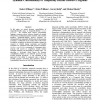TRIER
2002
14 years 5 months ago
2002
It is known that interprocedural detection of copy constants and elimination of faint code in parallel programs are undecidable problems, if base statements are assumed to execute...
AIPS
2009
14 years 6 months ago
2009
In this paper we extend dynamic controllability of temporally-flexible plans to temporally-flexible reactive programs. We consider three reactive programming language constructs w...
SOFTVIS
2006
ACM
14 years 11 months ago
2006
ACM
Visualizations of program executions are often generated on the fly. This has many advantages relative to off-line generation of animated video files. Video files, however, trivia...
PPOPP
2006
ACM
14 years 11 months ago
2006
ACM
Recently, the high-performance computing community has realized that power is a performance-limiting factor. One reason for this is that supercomputing centers have limited power ...
ICTAI
2008
IEEE
14 years 12 months ago
2008
IEEE
Frequent patterns in program executions represent recurring sequences of events. These patterns can be used to reveal the hidden structures of a program, and ease the comprehensio...
NORDSEC
2009
Springer
15 years 6 hour ago
2009
Springer
Runtime enforcement is a common mechanism for ensuring that program executions adhere to constraints specified by a security policy. It is based on two simple ideas: the enforceme...
IDA
2009
Springer
15 years 15 hour ago
2009
Springer
Abstract Deciding which computer architecture provides the best performance for a certain program is an important problem in hardware design and benchmarking. While previous approa...
POPL
2010
ACM
15 years 2 months ago
2010
ACM
Program analysis tools typically compute two types of information: (1) may information that is true of all program executions and is used to prove the absence of bugs in the progr...


